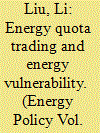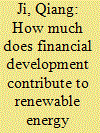|
|
|
Sort Order |
|
|
|
Items / Page
|
|
|
|
|
|
|
| Srl | Item |
| 1 |
ID:
192720


|
|
|
|
|
| Summary/Abstract |
Energy vulnerability has received sustained attention in global energy research related to energy security and poverty. However, energy quota trading (EQT), which aims to reduce energy consumption and intensity, has the potential to impact energy vulnerability substantially. This study scrutinizes the effect of EQT on energy vulnerability using a difference-in-difference model, relying on a quasi-natural experiment of China's EQT pilot. The findings show that EQT can significantly reduce energy vulnerability by 4.2%, which helps improve energy resilience. In addition, EQT can reduce the proportion of coal in energy consumption, thus reducing energy vulnerability. Finally, the ameliorating effect of EQT on energy vulnerability is particularly pronounced in areas with high resource dependence and low marketization. This research not only expands the understanding of the relationship between EQT and energy vulnerability, but also provides valuable assistance for future EQT policies from pilot to full-scale implementation.
|
|
|
|
|
|
|
|
|
|
|
|
|
|
|
|
| 2 |
ID:
188560


|
|
|
|
|
| Summary/Abstract |
This paper introduces the energy structure variables into the generalized cost function from the dual perspective of energy "structural dividend" and factor allocation distortion. It quantitatively estimates the factor allocative efficiency, cost elasticity and marginal cost of the energy decarbonization practice in China from 2004 to 2019. Estimation results show that: (i) there is a "structural dividend" effect of energy restructuring in China. On average, a 1% increase in the level of decarbonization of the energy structure reduces the total cost by 0.57% and the marginal cost by 5.846 billion yuan. Specifically, a 1% reduction in the share of coal consumption reduces the marginal cost by 4.590 billion yuan. (ii)Energy restructuring has accelerated factor allocation distortions in recent years. In terms of the impact of energy decarbonization on productivity growth, the inhibition of factor allocation distortion on productivity growth mainly comes from scale effect. (iii)Energy restructuring has a heterogeneous impact on productivity growth across provinces. Productivity growth in energy-consuming regions is lower than that in energy-supplying regions, while the regions where factor allocation distortions have a greater impact on productivity growth are mostly found in the central and western parts of the country where factor markets are less developed.
|
|
|
|
|
|
|
|
|
|
|
|
|
|
|
|
| 3 |
ID:
166444


|
|
|
|
|
| Summary/Abstract |
Developing renewable energy sector and upgrading energy structure have strategically important role in China's commitments against climate changes. Policymakers and authorities have put forward great efforts to make them happen. But one of the key constraints of China's energy revolution is financial issues, which is inevitably linking to the country's financial development. It is of great importance to understand how much financial development contributes to the renewable energy development in China, and more importantly what aspects of financial development matter. Through a time series analysis based on macro-level data, this paper provides clear evidence that financial development is critically important and contributes an overall of 42.42% to the variation of renewable energy growth. Specifically, we are able to demonstrate that capital market is the most important factor, followed by foreign investment. A simple comparison to the EU and the US cases indicates that the EU path is more relevant and should be studied more carefully by the Chinese policymakers.
|
|
|
|
|
|
|
|
|
|
|
|
|
|
|
|
| 4 |
ID:
171466


|
|
|
|
|
| Summary/Abstract |
In 2017, Taiwan announced that it would replace nuclear power, which accounts for approximately 4.43% of its total energy supply (or 8.30% of total electricity supply), with renewable energy by 2025. Thus developing reliable and stable renewable energy sources has become an urgent need. This study analyzes the portfolio of renewable energy technologies available to achieve such a goal. In doing such we consider potential of power generated from municipal solid waste (MSW), animal manure, energy crops, crop residues, wind power, and photovoltaic (PV) sources. The results show that up to an additional 5896 GWh (or million kWh) could be generated from recycled MSW, 3107 from animal manure, 6440 from energy crops and crop residues, 3685 from solar and 609 from wind power. Collectively, an increase in renewable energy production could expand to supply as much as 6.15% of current usage. Meanwhile, before replacing nuclear the use of fossil fuels can be reduced by up to 4.51%, increasing energy security, but a greater promotion on renewable energy development should be focused when nuclear power is phased out. We also discuss the cost of such a transition.
|
|
|
|
|
|
|
|
|
|
|
|
|
|
|
|
| 5 |
ID:
058045


|
|
|
|
|
|
|
|